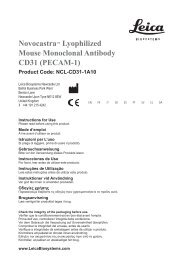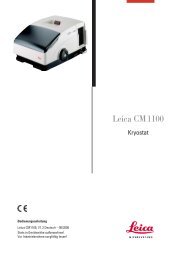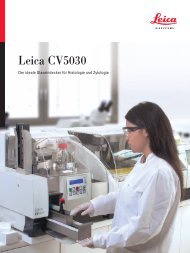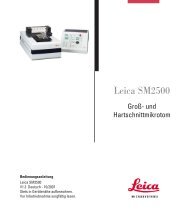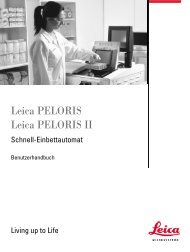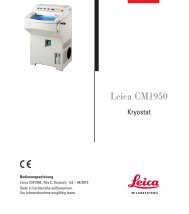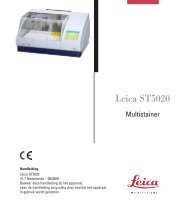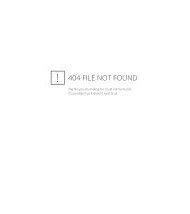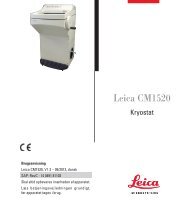Info - Leica Biosystems
Info - Leica Biosystems
Info - Leica Biosystems
You also want an ePaper? Increase the reach of your titles
YUMPU automatically turns print PDFs into web optimized ePapers that Google loves.
Liquid nitrogen due to its excessively cold temperature causes burns and protective clothing, including gloves and visor, should be used<br />
when handling. Use in a well ventilated area.<br />
Isopentane is highly flammable and harmful by ingestion and inhalation. It is also irritating to skin and eyes, and is a narcotic in high<br />
concentration.<br />
Quality Control<br />
Differences in tissue processing and technical procedures in the user’s laboratory may produce significant variability in results,<br />
necessitating regular performance of in-house controls in addition to the following procedures.<br />
Controls should be fresh autopsy/biopsy/surgical specimens frozen as soon as possible in the same manner as the patient sample(s).<br />
Positive Tissue Control<br />
Used to indicate correctly prepared tissues and proper staining techniques.<br />
One positive tissue control should be included for each set of test conditions in each staining run.<br />
A tissue with weak positive staining is more suitable than a tissue with strong positive staining for optimal quality control and to detect<br />
minor levels of reagent degradation. 2<br />
Recommended positive control tissue is skeletal muscle.<br />
If the positive tissue control fails to demonstrate positive staining, results with the test specimens should be considered invalid.<br />
Negative Tissue Control<br />
Should be examined after the positive tissue control to verify the specificity of the labeling of the target antigen by the primary antibody.<br />
Recommended negative control tissue has not been evaluated.<br />
Alternatively, the variety of different cell types present in most tissue sections frequently offers negative control sites, but this should be<br />
verified by the user.<br />
Non-specific staining, if present, usually has a diffuse appearance. Sporadic staining of connective tissue may also be observed in<br />
sections from excessively formalin-fixed tissues. Use intact cells for interpretation of staining results. Necrotic or degenerated cells often<br />
stain non-specifically. 3 False-positive results may be seen due to non-immunological binding of proteins or substrate reaction products.<br />
They may also be caused by endogenous enzymes such as pseudoperoxidase (erythrocytes), endogenous peroxidase<br />
(cytochrome C), or endogenous biotin (eg. liver, breast, brain, kidney) depending on the type of immunostain used. To differentiate<br />
endogenous enzyme activity or non-specific binding of enzymes from specific immunoreactivity, additional patient tissues may be stained<br />
exclusively with substrate chromogen or enzyme complexes (avidin-biotin, streptavidin, labeled polymer) and substrate-chromogen,<br />
respectively. If specific staining occurs in the negative tissue control, results with the patient specimens should be considered invalid.<br />
Negative Reagent Control<br />
Use a non-specific negative reagent control in place of the primary antibody with a section of each patient specimen to evaluate<br />
non-specific staining and allow better interpretation of specific staining at the antigen site.<br />
Patient Tissue<br />
Examine patient specimens stained with NCL-b-DG last. Positive staining intensity should be assessed within the context of any<br />
non-specific background staining of the negative reagent control. As with any immunohistochemical test, a negative result means that<br />
the antigen was not detected, not that the antigen was absent in the cells/tissue assayed. If necessary, use a panel of antibodies to<br />
identify false-negative reactions.<br />
Results Expected<br />
Normal Tissues<br />
Clone 43DAG1/8D5 detects the beta-dystroglycan protein in the sarcolemma of skeletal muscle fibers.<br />
Abnormal Tissues<br />
Clone 43DAG1/8D5 has been used in immunohistochemical and immunoblotting studies of more than 930 patients to identify a<br />
deficiency of the 43 kD dystrophin-associated glycoprotein, beta-dystroglycan.<br />
NCL-b-DG is recommended for use as part of a panel of antibodies in immunohistochemistry to direct genetic mutation<br />
analysis in the diagnosis and differentiation of the recessive and X-linked muscular dystrophies. In particular, to identify a<br />
reduction in beta-dystroglycan labelling in some forms of muscular dystrophy where another component, eg dystrophin, is<br />
directly affected.<br />
General Limitations<br />
Immunohistochemistry is a multistep diagnostic process that consists of specialized training in the selection of the appropriate reagents;<br />
tissue selection, fixation, and processing; preparation of the IHC slide; and interpretation of the staining results.<br />
Tissue staining is dependent on the handling and processing of the tissue prior to staining. Improper fixation, freezing, thawing, washing,<br />
drying, heating, sectioning or contamination with other tissues or fluids may produce artefacts, antibody trapping, or false negative<br />
results. Inconsistent results may be due to variations in fixation and embedding methods, or to inherent irregularities within the tissue. 4<br />
Excessive or incomplete counterstaining may compromise proper interpretation of results.<br />
The clinical interpretation of any staining or its absence should be complemented by morphological studies using proper controls and<br />
should be evaluated within the context of the patient’s clinical history and other diagnostic tests by a qualified pathologist.<br />
Antibodies from <strong>Leica</strong> <strong>Biosystems</strong> Newcastle Ltd are for use, as indicated, on either frozen or paraffin-embedded sections with specific<br />
fixation requirements. Unexpected antigen expression may occur, especially in neoplasms. The clinical interpretation of any stained<br />
tissue section must include morphological analysis and the evaluation of appropriate controls.<br />
NCL-b-DG<br />
Page 3



